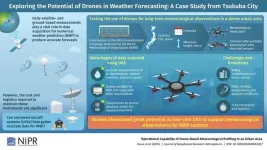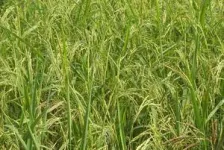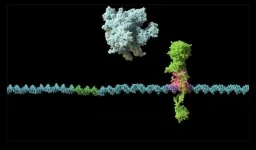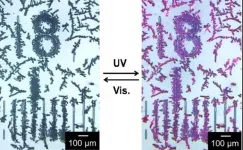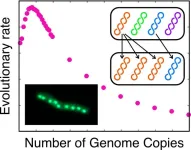(Press-News.org)
Climate change is making extreme weather events worse, empowering meteorological phenomena such as storms, hurricanes, heatwaves, and droughts. Against this backdrop, numerical weather predictions (NWPs), which use complex mathematical models that simulate atmospheric conditions, have become critical to protect people and businesses from these events and other weather-borne disasters.
Unsurprisingly, NWP models need a massive amount of daily data to make accurate predictions. While some of this data comes from satellite images and ground-based stations, a fine atmospheric vertical structure is collected by sensors mounted on weather balloons, released simultaneously every day by meteorological agencies worldwide. These snapshots of temperature, humidity, pressure, and wind at different altitudes provide a detailed, real-time picture of the atmosphere that helps scientists initialize NWP models. However, maintaining weather balloon observations is a costly and difficult task, which severely limits the spread and coverage of daily measurements. But what if inexpensive drones equipped with sensors could help support NWPs just like weather balloons do?
In a recent study, a research team led by Professor Jun Inoue from the National Institute of Polar Research, Japan, conducted a two-month field campaign in Tsukuba City to investigate whether daily drone-based measurements could be seamlessly made and uploaded to support NWPs. The study was made available online on December 28, 2024, and was published in Volume 130, Issue 1 of the Journal of Geophysical Research: Atmospheres on January 16, 2025.
“We instigated this field campaign to assess the feasibility of obtaining continuous daily measurements during a period of at least one month using uncrewed aircraft systems (UASs) or drones, to distribute the data in a format designated for NWP, and to evaluate data quality compared to that obtained using more conventional meteorological methods,” says Prof. Inoue.
During a two-month period, the research team tested three different types of drones. One of them was a meteorological hexacopter with a suite of built-in meteorological sensors, whereas the other two were commercial quadcopter drones onto which meteorological sensors were mounted. Because of flight regulations in urban areas, drones could only ascend to a maximum height of 900 m. Every day during the study period, members of the team would launch these drones at designated times and use a laptop to convert the gathered data into an appropriate format before uploading it.
The researchers compared the data obtained using the drones with routine radiosonde data gathered nearby using weather balloons. Notably, air temperature, humidity, and wind speed measurements from drones did not differ significantly from those of weather balloons, underlining the potential of these devices to support NWP systems in a very cost-effective way. Moreover, data could be converted and uploaded within 30 minutes of making the measurements, which aligns well with current standard operational procedures.
“The results of our field campaign showed that twice-daily UAS profiling is feasible from the viewpoint of data quality and data transfer for the NWP systems,” says Prof. Inoue. He further adds, “We also highlight that long-term data validation for each UAS using well-established reference instruments is critical to demonstrate the operational capability of drones for next-generation meteorological observation systems.”
The benefits of using inexpensive drones to make daily meteorological measurements are manifold. They can be easily implemented in sparse meteorological observation areas, such as polar regions, developing countries, and mountain areas, to complement conventional systems. Since special academic knowledge is not required, trained locals can conduct the necessary tasks and extend the range and density of meteorological data throughout the globe. In turn, this could significantly improve the accuracy of NWP systems, leading to accurate weather forecasting and, most importantly, disaster prevention via early warning.
###
About National Institute of Polar Research, Japan
Founded in 1973, the National Institute of Polar Research (NIPR) is an inter-university research institute that conducts comprehensive scientific research and observations in the polar regions. NIPR is one of the four institutes constituting the Research Organization of Information and Systems (ROIS) and engages in comprehensive research via observation stations in the Arctic and Antarctica. It strives to promote polar science by soliciting collaboration research projects publicly, as well as by providing samples, materials, and information. NIPR plays a special role as the only institute in Japan that comprehensively pursues observations and research efforts in both the Antarctic and Arctic regions.
Website: https://www.nipr.ac.jp/english/index.html
About Professor Jun Inoue from National Institute of Polar Research, Japan
Dr. Jun Inoue obtained his Master’s and PhD degrees from Hokkaido University, Japan, in 1999 and 2001, respectively. He currently serves as a Professor at the National Institute of Polar Research, Japan. His research interests lie in the fields of atmospheric and hydrosphere science, particularly in the Arctic and Antarctic regions. He has published over 114 papers on these topics and has received awards from the Japan Meteorological Society on three occasions.
About the Research Organization of Information and Systems (ROIS)
ROIS is a parent organization of four national institutes (National Institute of Polar Research, National Institute of Informatics, the Institute of Statistical Mathematics and National Institute of Genetics) and the Joint Support-Center for Data Science Research. It is ROIS's mission to promote integrated, cutting-edge research that goes beyond the barriers of these institutions, in addition to facilitating their research activities, as members of inter-university research institutes.
END
Silicon (Si) is one of the most abundant elements on Earth, found in large quantities in soil. While Si is not essential for land plants, many plants, such as rice and grasses, have used Si to develop powerful defense mechanisms against various environmental stresses. Si accumulates in plant leaves and aerial organs as amorphous silica (SiO2), which offers protection against pathogens, herbivores, and environmental challenges like drought. Understanding the processes through which plants manage this beneficial element could enhance crop resilience and productivity, especially in the face of climate change.
In a breakthrough study, ...
An international collaboration has achieved an important breakthrough in understanding the genetic mechanisms that allow bacteria to build resistance to drugs.
Bacteria have multiple defence mechanisms they can use to build resistance to antibiotics, one of the major problems facing public health globally.
One of these mechanisms involves plasmids, small DNA molecules in bacterial cells, which have their own independent genome and carry antibiotic resistance.
If we can work out the roles plasmids play inside bacteria, then we can use the information to develop a new generation of therapeutics that can target drug resistant infections.
John ...
Proteins are life’s engines, powering processes like muscle movement, vision, and chemical reactions. Their environments—water, lipid membranes, or other condensed phases—are critical to their function, shaping their structure and interactions.
Yet many modern protein-design methods, including AI-based tools, often ignore how these surroundings influence proteins. This gap limits our ability to create proteins with new functions, slowing progress in medicine and bioengineering.
One group of proteins working in such specialized ...
Bethesda, MD (Jan. 22, 2025) — The American Gastroenterological Association (AGA) has unveiled an updated clinical practice guideline in Gastroenterology addressing the prevention and management of hepatitis B virus reactivation (HBVr) in patients on immunosuppressive drugs. The use of immunosuppressive drugs has increased significantly since 2013, according to data gathered via the National Health Interview Survey.
New tailored risk assessments can help health care providers and patients navigate challenges posed by the newer immunosuppressive therapies used for oncology, rheumatology, and gastrointestinal diseases. As the ...
Adults who have been diagnosed with attention deficit hyperactivity disorder (ADHD) may be living shorter lives than they should, finds a world-first study led by UCL researchers.
The research, published in The British Journal of Psychiatry, analysed anonymised primary care data from 30,029 adults across the UK with diagnosed ADHD.
They then compared this group with 300,390 participants without ADHD, who were matched by age, sex, and primary care practice.
The researchers found an apparent reduction in life expectancy for men with diagnosed ADHD of between 4.5 and 9 years, and between 6.5 and 11 years for women.
Senior author, ...
The fossilised neck bone of a flying reptile unearthed in Canada shows tell-tale signs of being bitten by a crocodile-like creature 76 million years ago, according to a new study published today [23 January] in the Journal of Palaeontology.
The juvenile pterosaur vertebra, discovered in Dinosaur Provincial Park, Alberta, bears a circular four-millimetre-wide puncture mark from a crocodilian tooth. Researchers from the Royal Tyrrell Museum of Palaeontology (Canada), the University of Reading (UK) and the University of New England (Australia) say this rare evidence provides insight into predator-prey dynamics ...
The results of cowslip observations carried out with the help of citizen scientists from 32 countries in over 5,200 locations shed light on the well-being of insect-pollinated plants under changing climate and land use conditions. The study was made possible thanks to the contribution of European science enthusiasts. It revealed some surprising results recently published in the Journal of Ecology, one of the longest-standing top-level journals in this field.
The cowslip (Primula veris) is considered a model species for studying insect-pollinated plants. Cowslips can have two types of flowers: long-styled (L-morph) and short-styled (S-morph). In L-morph flowers, ...
Photomechanical materials made of photochromic crystals, which change their molecular structure reversibly in response to light, have the potential to impact fields from semiconductors to pharmaceuticals. For the first time in the world, an Osaka Metropolitan University team has developed a crystal patterning method demonstrating that it is possible to control the orientation of photochromic crystals known as diarylethenes.
Diarylethene crystals not only change color when exposed to UV light, but also undergo various shape changes as the molecular structure ...
Quantum entanglement – a phenomenon where particles are mysteriously linked no matter how far apart they are – presents a long-standing challenge in the physical world, particularly in understanding its behaviour within complex quantum systems.
A research team from the Department of Physics at The University of Hong Kong (HKU) and their collaborators have recently developed a novel algorithm in quantum physics known as ‘entanglement microscopy’ that enables visualisation and mapping of this extraordinary phenomenon at a microscopic scale. By zooming in on the intricate ...
Evolution is the basis of biological diversity, driven by mechanisms that allow organisms to adapt and survive. One such mechanism is polyploidy, where organisms carry extra copies of their genomes. While polyploidy provides genetic redundancy by allowing mutations without affecting survival, it can also slow evolutionary progress by diluting beneficial mutations. This paradox has intrigued scientists for many years now, and a recent study from Earth-Life Science Institute (ELSI) at Institute of Science Tokyo offers new insights into polyploidy's role in evolution. Led by ELSI’s ...
